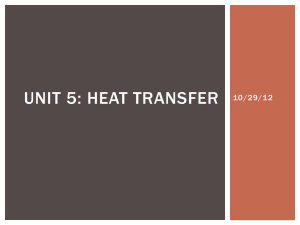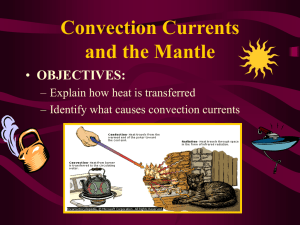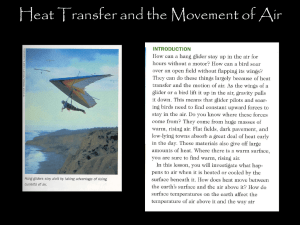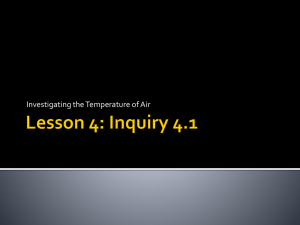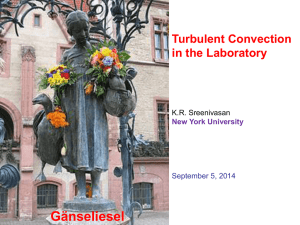08.internal convection
advertisement
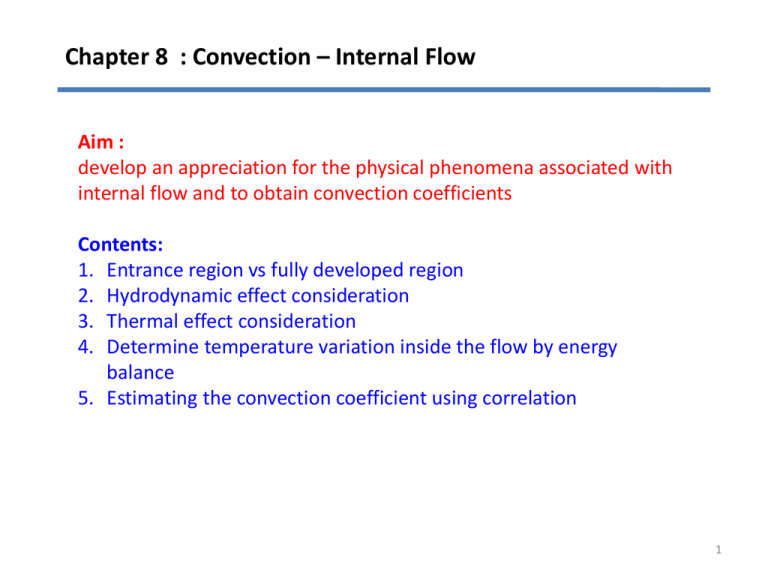
Chapter 8 : Convection – Internal Flow Aim : develop an appreciation for the physical phenomena associated with internal flow and to obtain convection coefficients Contents: 1. Entrance region vs fully developed region 2. Hydrodynamic effect consideration 3. Thermal effect consideration 4. Determine temperature variation inside the flow by energy balance 5. Estimating the convection coefficient using correlation 1 INTRODUCTION • Liquid or gas flow through pipes or ducts is commonly used in heating and cooling applications and fluid distribution networks. • The fluid in such applications is usually forced to flow by a fan or pump through a flow section. • The fluid velocity in a pipe changes from zero at the wall because of the no-slip condition to a maximum at the pipe center. • In fluid flow, it is convenient to work with an average velocity Vavg, which remains constant in incompressible flow when the cross-sectional area of the pipe is constant. 2 2 Chapter 8 : Convection – Internal Flow Flow Conditions/profile : Entrance region vs. fully developed region • Must distinguish between entrance region and fully developed region. • In entrance region, the effect can be due to: 1. Hydrodynamic (velocity variation) 2. Thermal (temperature variation) • Hydrodynamic entrance region vs. Fully developed region 1 • Thermal entrance region vs. Fully developed region 2 3 Entrance Conditions Entrance Conditions • Hydrodynamic Effects: - Consider laminar flow with uniform velocity profile at inlet of a circular tube. – Velocity boundary layer develops on surface of tube and thickens with increasing x. – Inviscid region of uniform velocity shrinks as boundary layer grows. – Subsequent to boundary layer merger at the centerline, the velocity profile becomes parabolic and invariant with x. The flow is then said to be hydrodynamically fully developed. How would the fully developed velocity profile differ for turbulent flow? -For turbulent flow, the profile is flatter due to turbulent mixing in radial direction Entrance Conditions Entrance Conditions • Thermal Effects: - Assume laminar flow with uniform temperature, T(r,0) = Ti, at inlet of circular tube with uniform surface temperature or heat flux. – Thermal boundary layer develops on surface of tube and thickens with increasing x. – Isothermal core shrinks as boundary layer grows. – Subsequent to boundary layer merger, dimensionless forms of the temperature profile (for Ts and qs) become independent of x. Conditions are then said to be thermally fully developed Why it is necessary to identify entrance region and fully developed region ? Hydrodynamically fully developed: Variation of the friction factor and the convection heat transfer coefficient in the flow direction for flow in a tube (Pr > 1). Thermally fully developed: Surface heat flux: *Fully developed flow: The region in which the flow is both hydrodynamically and thermally developed. 6 In the thermally fully developed region of a tube, the local convection coefficient is constant (does not vary with x). Therefore, both the friction (which is related to wall shear stress) and convection coefficients remain constant in the fully developed region of a tube. Variation of the friction factor and the convection heat transfer coefficient in the flow direction for flow in a tube (Pr > 1). The pressure drop and heat flux are higher in the entrance regions of a tube, and the effect of the entrance region is always to increase the average friction factor and heat transfer coefficient for the entire tube. Next step : How to calculate the length of entrance region & fully developed region ? 7 Chapter 8 : Convection – Internal Flow Hydrodynamic Entry Length & Thermal Entry Length Entry Length depend on whether the flows is laminar or turbulent, which in turn, depend on Reynolds number. For a circular tube, For flow through noncircular tubes, the Reynolds number as well as the Nusselt number, and the friction factor are based on the hydraulic diameter, Dh The fluid properties in internal flow are usually evaluated at the bulk mean fluid temperature, which is the arithmetic average of the mean temperatures at the inlet and the exit: Tb = (Tm, i + Tm, e)/2. 8 Chapter 8 : Convection – Internal Flow For internal flow, onset of turbulence occurs at a critical Reynolds number of ReD,c 2300 Fully turbulent conditions exist for ReD,c 10,000 Hydrodynamic entry length, xfd,h : The length of the hydrodynamic entrance region. Thermal entry length, xfd,t : The length of the thermal entrance region. Laminar flow Turbulent flow 9 Chapter 7 : Convection – Internal Flow 10 Chapter 7 : Convection – Internal Flow In fluid flow, it is convenient to work with an average or mean temperature Tm, which remains constant at a cross section. The mean temperature Tm changes in the flow direction whenever the fluid is heated or cooled. 11 Chapter 7 : Convection – Internal Flow Problem 8.6a: Consider pressurised water, engine oil (unused) and NaK _(22-78%) flowing in a 20 mm diameter tube. Determine the mean velocity, the hydrodynamic entry length and the thermal entry length for each of the fluids when the fluid temperature is 366K and the flow rate is 0.01 kg/s 12 Chapter 7 : Convection – Internal Flow 13 Chapter 7 : Convection – Internal Flow and power requirement (to overcome the flow resistance associated with this pressure drop): 14 15 Chapter 7 : Convection – Internal Flow Problem 8.3: Water at 27C flows with a mean velocity of 1 m/s through a 1 km pipe of 0.25 m inside diameter. Determine the pressure drop over the pipe length and the corrsponding pump power requirement if a) the pipe is smooth b) The pipe is made of cast iron 16 Chapter 7 : Convection – Internal Flow *This mean, in thermally fully developed flow (for constant properties) the local convection coefficient is a constant, independent of x. 17 Chapter 7 : Convection – Internal Flow Entrance region Fully developed 18 GENERAL THERMAL ANALYSIS Rate of heat transfer Surface heat flux The thermal conditions at the surface can be approximated to be • constant surface temperature (Ts= const) or • constant surface heat flux (qs = const). hx is the local heat transfer coefficient. The constant surface temperature condition is realized when a phase change process such as boiling or condensation occurs at the outer surface of a tube. The constant surface heat flux condition is realized when the tube is subjected to radiation or electric resistance heating uniformly from all directions. We may have either Ts = constant or qs = constant at the surface of a tube, but not both. The heat transfer to a fluid flowing in a tube is equal to the increase in the energy of the fluid. 19 Chapter 7 : Convection – Internal Flow – Energy Balance P = surface perimeter = D for a circular tube 20 Chapter 7 : Convection – Internal Flow – Energy Balance Eq. (8.40) Eq. (8.38) 21 Chapter 7 : Convection – Internal Flow – Energy Balance Problem 8.16a: Atmospheric air enters the heated section of a circular tube at a flow rate of 0.005 kg/s and a temperature of 20C. The tube diameter is 50 mm and fully developed conditions with h = 25 W/m2K exist over the entire length of 3 m. For the case of uniform surface heat flux at q”s= 1000 W/m2, determine the total heat transfer rate and the mean temperature of the air leaving the tube, Tm,o. What is the value of the surface temperature at the tube inlet Ts,i and outlet, Ts,o ? 22 Chapter 7 : Convection – Internal Flow – Energy Balance Eq. (8.41b) Log mean temp. difference 23 Chapter 7 : Convection – Internal Flow – Energy Balance Ū is the average overall heat transfer (defined in Section 3.3.1) Eqs. (8.45a) & (8.45b) 24 Chapter 7 : Convection – Internal Flow – Energy Balance Problem 8.17b: Water at 300K and a flow rate of 5 kg/s enters a black thin-walled tube, which passes through a large furnace whose walls and air are at a temperature of 700K. The diameter and length of the tube are 0.25 m and 8 m. Convection coefficient associated with water flow through the tube and air flow over the tube are 300 W/m2K and 50 W/m2K respectively. Determine the outlet temperature of the water. 25 Chapter 7 : Convection – Internal Flow Eq. (8.53) Eq. (8.55) Eq. (8.60) Validity: 0.7 Pr 160 ReD 10,000 L/D 10 Eq. (8.62) Validity: 0.5 Pr 2000 3000 ReD 5x106 26 Chapter 7 : Convection – Internal Flow 27 Other equations (Turbulent flow-fully developed) When the variation in properties is large due to a large temperature difference: Eq. (8.61) All properties are evaluated at Tb except s, which is evaluated at Ts. Eq. (8.60), (8.61) or (8.62) 28 Chapter 7 : Convection – Internal Flow 29 Chapter 7 : Convection – Internal Flow Problem 8.37a: Atmospheric air enters a 10m long, 150 mm diameter uninsulated heating duct at 60C and 0.04 kg/s. The duct surface temperature is approximately constant at 15 C. What are the outlet air temperature, the heat rate and pressure drop for these conditions ? 30 Chapter 7 : Convection – Internal Flow 31 Chapter 7 : Convection – Internal Flow Eq. (8.56) •Applicable to all situations where the velocity profile is already fully developed • Pr 5 Eq. (8.57) 32 Chapter 7 : Convection – Internal Flow Problem 8.22a: Engine oil is heated by flowing through a circular tube of diameter 50mm and length 25m. The tube surface is maintained at 150C. If the flow rate and inlet temperature of the oil are 0.5 kg/s and 20 C, what is the outlet temperature ? What is the total heat transfer rate for the tube ? 33
